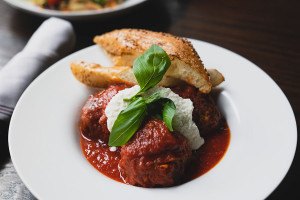Scoring the Good Stuff At…JG Domestic
Hands down, the best movie ever made about chefs and their trade is Big Night. There are those who would argue that this is the only good movie ever made about cooks and kitchens (a position I would not argue too strongly against), and that every other film in the galley-opera oeuvre is nothing but a steaming pile of fantastical crap full of cooks who don’t cook, customers who never complain and polished, white-toothed chefs with perfect hair and no scars.
Big Night, though, was different. Big Night was full of pain and humiliation, betrayal, heartbreak and obsession. Big Night had the timpano for Louis Prima, the fight on the beach, Secondo’s omelet–a single long, wordless take which did more to burn the film into the hearts of cooks everywhere than any other because in it exists every reason that good cooks have for doing what they do every night.
More to the point here, Big Night has this brilliant scene, early on in the story, where an older couple comes into the Italian restaurant being run by brothers Primo and Secondo. They order a seafood risotto and, when it arrives (having been done perfectly by Primo, made with seafood stock, but presented only as pinkish rice with no shrimp, no big chunks of lobster), they ask, okay, but where’s the seafood? Secondo tries to explain that the seafood is in there–that the best parts of the seafood, the essence of the seafood, is all right there. But these people don’t care. All they want is to see a pile of shrimp on their plate. All they care about is that they thought they were going to be eating lobster.
At JG Domestic, the menu is a carnival ride of smart, name-checked and geo-tagged dishes where place is given almost as much attention as product. The popcorn on the bar snacks board is not just organic, but Iowa organic. The carpaccio is not just wagyu, but comes from Strube Ranch in Pittsburg (Texas). The morels are from California, the Pekin duck from Pennsylvania, the fondue is made from Keswick Creamery cheese and the lobster cappuccino with butternut squash dumplings and vanilla emulsion is made from lobsters that hail from Maine and have traveled all the way down the coast just to form the base of your $14 cup of soup.
And it was worth the trip, totally. A lobster could do worse than to grow up to be a part of this soup, and considering the lack of locally-grown lobsters (difficult to come by unless one starts dropping traps into the shellfish tanks at the National Aquarium), and the fact that JG operates like a clearing house for all that’s green or bloody or delicious in the American foodshed, I’m not the least bit bothered by the number of miles those lobsters (and those morels, that corn) put on before arriving. But while I was frantically scraping up every mouthful of this stuff and wondering what kind of looks I’d get were I to dip my napkin into the dregs and squeeze the last drops onto my tongue, Big Night was definitely on my mind.
Why? Because I’d been served a lobster cappuccino–called that because of its creamy brown color, its head of foam (yes, foam), and the oversized coffeeshop mug it was served in–with no lobster in it. Or rather with lobster in it, of course, but no big, fat chunks of lobster so that, sitting there (knocking down bottles of Victory, waiting on my mains and doing my level best to avoid every other one of my days responsibilities that did not revolve around cold lager and pretend coffee made from shellfish), I couldn’t help but imagine the risotto scene from Big Night being played out over and over again on JG’s floor. I envisioned confused diners, unaware or unaccustomed to the kind of new/old culinary legerdemain being practiced by the white jackets in the open-plan display kitchen, hunched over their cutesy mugs, stirring up their soups from the bottom, waiting to see shreds of claw or nuggets of tail bobbing up from the depths but finding only a couple of small, hand-crimped dumplings full of butternut squash puree and a stick of chive gone limp in the heat.
In Big Night, the couple did not try the risotto. They sat there, staring at it like they’d been served a plate of pink fiberglass insulation garnished with fingernail clippings while Secondo sweated and tried to explain how there was seafood in the risotto, but that you just couldn’t see it. In the end, they asked for spaghetti.
On the floor at JG, you only have to taste the lobster cappuccino–only need to smell it–to know exactly what you’re paying for, meat or no meat. The flavor is smooth and deep: brown butter, scalded cream, a bit of sweetness (sugars gone all dark and caramely in the heat) followed by the luxurious wash of fatty richness which carries on its back a taste of lobster more pure and powerful than jamming an entire tail in your mouth at once. Built up in layers from a strong stock, alternately muffled and brightened by cream, by vanilla, by the barest green vegetable spike of chive, it is an amazing soup. And to bite in half one of the little butternut dumplings and get the added rush of savory sweetness is to experience a rare and perfect equipoise of flavors–which sounds so easy on paper (stock, cream, herbs and done, right?) but, in practice, is a high-wire act with nothing but failure on either side.
Why? Because the dish itself is ridiculous. It’s cutesy, it falls dangerously close on the bad-ideas-in-food spectrum to one of those faux-food creations (lobster corndogs with jalapeno relish! dessert hamburgers made of marzipan!) that plagued menus back in the early 90’s, it involves a foam (kiss of death among galley traditionalists these days) and an emulsion (which are just fine today, but 15 years ago would’ve gotten a chef kicked in the nuts for being uppity and playing too much with his food), and if not for the fact that it is so good and so ideally constructed, it would’ve been nothing more than a weird, retro one-off on a menu otherwise full of hearty American fare like baby back ribs with fried apples, potato cassoulet (heirloom, of course) and whole suckling pigs dressed in nothing more complicated than garlic and rosemary.
But still, it is that good. Its plain awesomeness trumps all discussions of provenance or inspiration. And like Primo’s risotto, mounded up all pink and naked on the plate, JG’s lobster cappuccino is surprising, defining, and the kind of thing that you simply have to taste to understand.
So, seriously, what are you waiting for?



